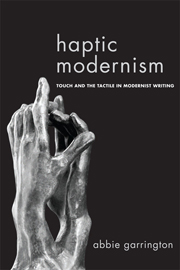Book contents
1 - Haptic Modernism
Published online by Cambridge University Press: 05 September 2013
Summary
Modernist manicures
In Sinclair Lewis's 1922 novel Babbitt, we first meet our eponymous hero at rest in his sleeping-porch, where his recumbent body may be read: ‘He was not fat but he was exceedingly well fed; his cheeks were pads, and the unroughened hand which lay helpless upon the khaki blanket was slightly puffy. He seemed prosperous, extremely married and unromantic’ (Lewis 1950: 2). Babbitt's choice of bed, in a space related only tangentially to the main body of the house, and removed from the conjugal chamber, leads the reader to suppose he may not be as ‘extremely’ married as the narrative voice would have us believe. For Rebecca West, this initial approach to a slumbering Babbitt is part of Lewis's exhaustive study of an inconsequential man, for ‘we know the poor fatuous being in his standing up and his lying down’ (West 1987a: 272). Lamenting the ‘planless’ quality of the novel, West states that ‘its end arrived apparently because its author had come to the end of the writing-pad, or rather, one might suspect from its length, to the end of all writing-pads then on the market’ (271). Whatever the meanderings of the story, West concedes that Babbitt constitutes ‘a triumph of impersonation’ and ‘a bit of character-exhibition comparable to [Charles Dickens's] Mr. Micawber’ (271). To the detriment of the world's paper stocks, then, Lewis achieves an insight into the (vertical and horizontal) life of a suburban estate agent in the year 1920.
- Type
- Chapter
- Information
- Haptic ModernismTouch and the Tactile in Modernist Writing, pp. 1 - 72Publisher: Edinburgh University PressPrint publication year: 2013



